Vectors: One System for Putting Less Stress on the Tree and Climber
As with any technical undertaking, there are various ways to mitigate or dissipate force in our rigging systems. From simple to complex, we have several variables we can manipulate to achieve a common goal of putting less stress on the tree, system and climber. This article will discuss one such method.

The goal is to give tree workers progressive and applicable options in a wide variety of situations. We will shy away from formulas, calculations and other specific metrics in lieu of rules of thumb and anecdotal,
experienced-based guides and recommendations. While specific numbers and calculations are important, the principles of load management are more important than the measurable numbers when working in the field. Also, accurate measurement and repeatable results are very difficult when dealing with growing and changing trees.
To begin our discussion, we must define terms and look at concepts that verge on science, physics and geometry. However, we do so with the broadest brush. As always, the idea is not to conduct a math lesson, but to establish a principle we can use and apply to many methods. There is always more than one way to accomplish a task safely and efficiently. If we can agree on our terms and concepts, we can apply them consistently.
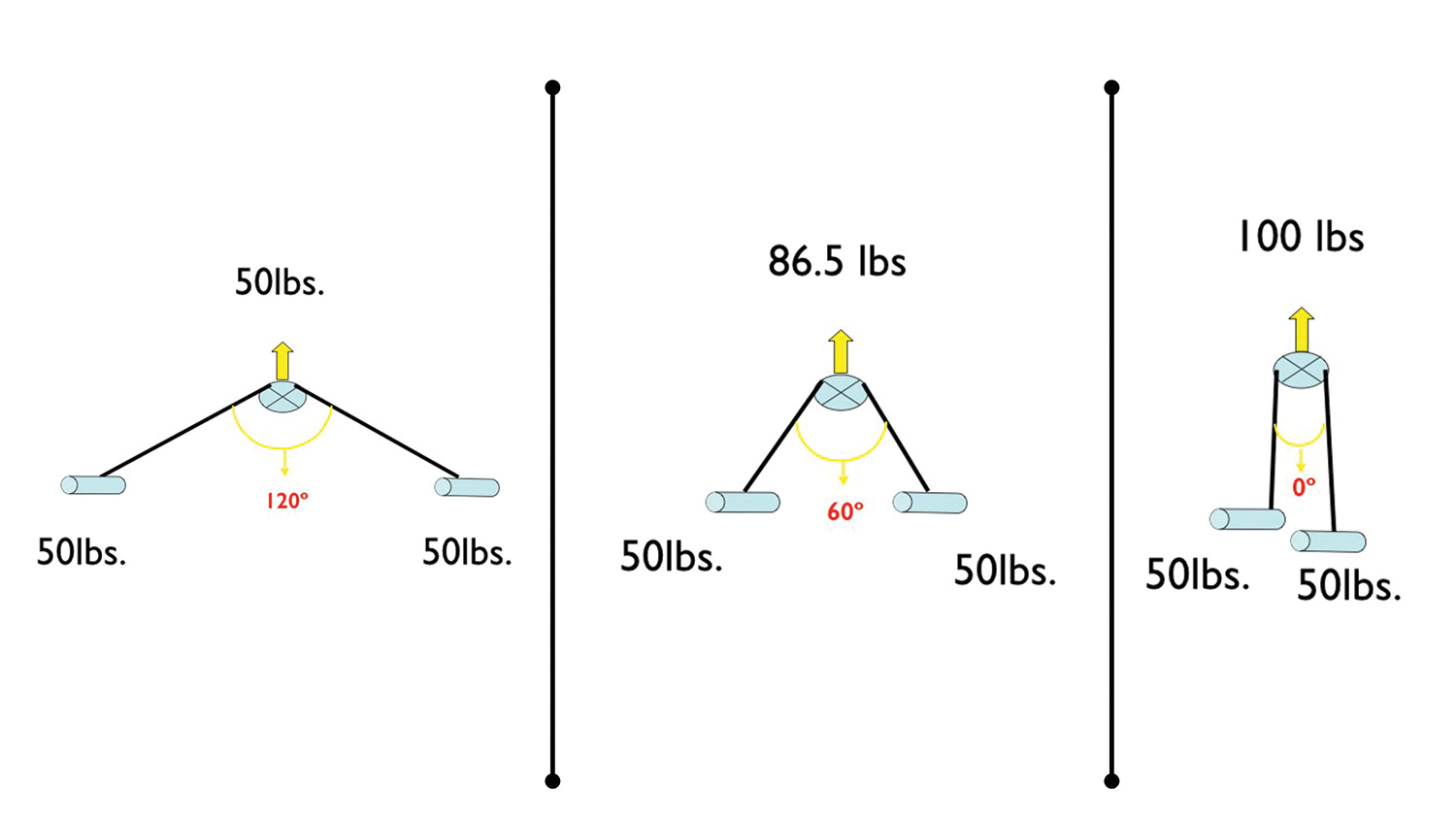
Defining vectors and force
The term “vector” is often used and bantered about by arborists. However, it is seldom understood, as it is often misapplied or needlessly added. It is entirely possible to rig safely without defining the term vector. However, a solid definition will add clarity and allow us to glean insight into why this final technique for force management is a valuable tool for the mental rigging toolbox.
At its most basic, a vector is an object that has both a magnitude and a direction. We will take it a bit further and add a simple definition of the term “force.” Force is defined as the push or pull on an object with mass causing it to change its velocity. Force is an external agent capable of changing a body’s state of rest or motion. It has a magnitude and a direction as well.
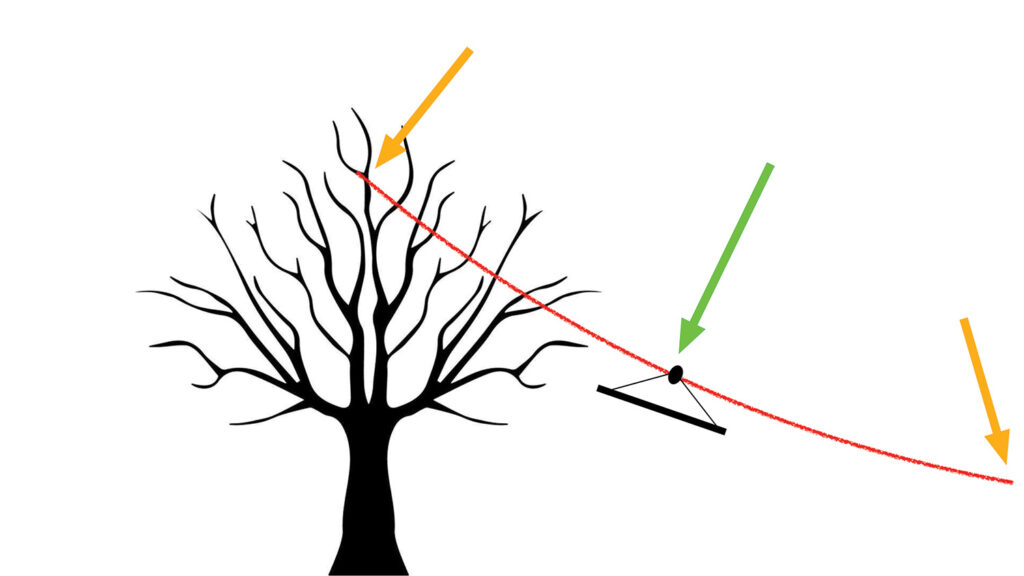
Application of definitions
Again, a vector is an object with magnitude and direction. Force is a push or pull on an object, moving it from a state of rest. It, too, has magnitude and direction. Therefore, the term “vector force” is a misnomer at worst, a useless redundancy at best. While this may seem as if I am splitting hairs, accurate definitions of our terms allow us to describe and understand the techniques we are discussing.
So force is the agent of load movement in arborist rigging. The most common force is gravity – things falling – and mechanical – things being pulled or lifted. The vector is the object’s path of motion once force is applied. We are limited in controlling the application of force, especially gravity. We have many options when it comes to controlling vectors. It is the basis of our final technique. We will affect force by manipulating vectors with this final rigging strategy.
Combining vectors
Since we live in a three-dimensional universe, vectors rarely come alone. Each new direction and/or force causes a different vector. These separate vectors add and cause new vectors. While this may seem foreign and overtly complex, I assure you it need not be. If you have a basic understanding of tree rigging and/or climbing, you already have seen this in action. We discussed earlier how letting a piece “run” can dissipate force. This is vector manipulation. We are using distance to slow acceleration.
The reason we are taking a detailed look at the definitions and principles is because, like all variables if applied poorly, vectors can make a rigging situation worse. Just as we can use good tools for poor craftsmanship, so, too, can we use excellent techniques poorly and achieve disastrous results. The converse is also true. With good definitions and understanding, we can make rigging scenarios better.
A simple application
As we add vectors to a system, the loads change in magnitude and direction. When I was 13 years old and learning to sail, my mentor showed me a way to tighten a halyard running up the mast without a winch. Once we had pulled the halyard as tightly as possible and secured it, we would then grab the vertical run of rope going up the mast as high as possible. Then, with as much muscle as I could muster, I pulled perpendicular to the run of the rope, or straight out at 90 degrees to the mast. At the peak of my pull, I would let go and another crew member would take in the slack created upon my release.
This was called “sweating” the line. By applying a vector 90 degrees to the initial load, I increased force on both anchor points. When I released my force, the resulting force was absorbed at the deck anchor by my crewmate. The closer to the center point of the vertical load I could pull, the more my introduced vector would affect the load at the anchors. This is a technique I still use and teach as a simple way to tighten a lowering line coming out of a lowering device. (Figure 1) It also is an excellent way to increase pulling force on a pull line when falling trees.
A disadvantageous application
Sweating a halyard on a sailboat or taking up slack in a lowering line both enhance our task. However, the same vector can cause problems if not accounted for. Take, for instance, a speed or zip line. The speed line is anchored above the load in the tree and then runs at an angle to an anchor on the ground. As the load moves down the speed line, the vector changes the load on the anchors. When the load is directly in the center of the speed line, the load on the anchors will be roughly equal and the greatest. If force is applied (another vector) to keep the load aloft over an obstacle, the force at the two anchor points can become quite high. Even a relatively light load initially can magnify anchor loads a lot. (Figure 2)
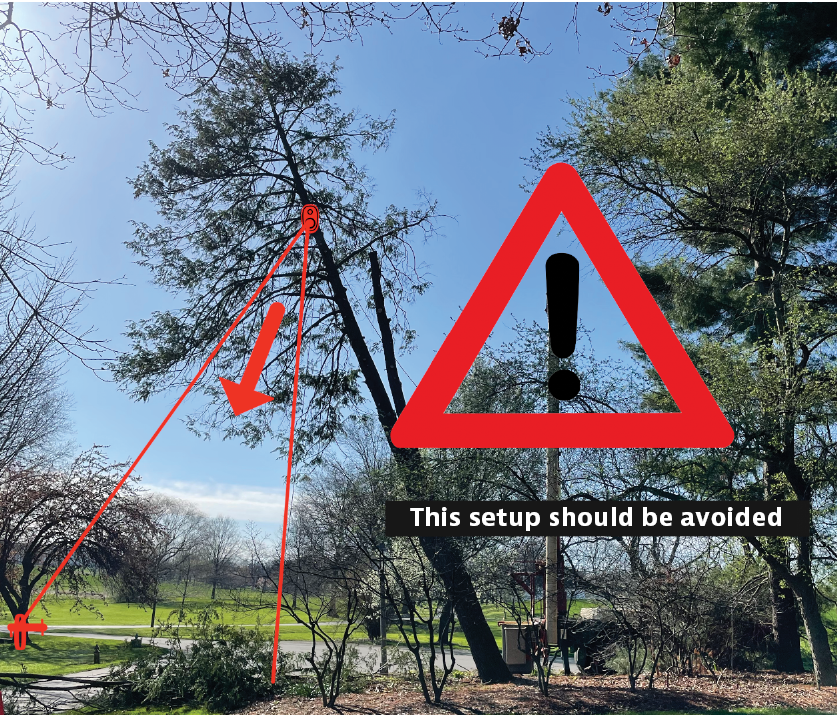
Solutions
Depending on tree lean and loading when rigging, vectors can make things better or worse. On this leaning hemlock (Tsuga canadensis), choosing the correct placement of the lowering device can greatly alter the stability of the rigging system. (Photos 1-2)
By moving anchor points on a speed-line setup, we can add vectors and start to load the tree in compression and help it bear the loads we inflict, as it was designed to do by nature. If we anchor in line, below and behind our top anchor point, we essentially use the same concept as is used with suspension bridges for strength and stability. (Figure 3)
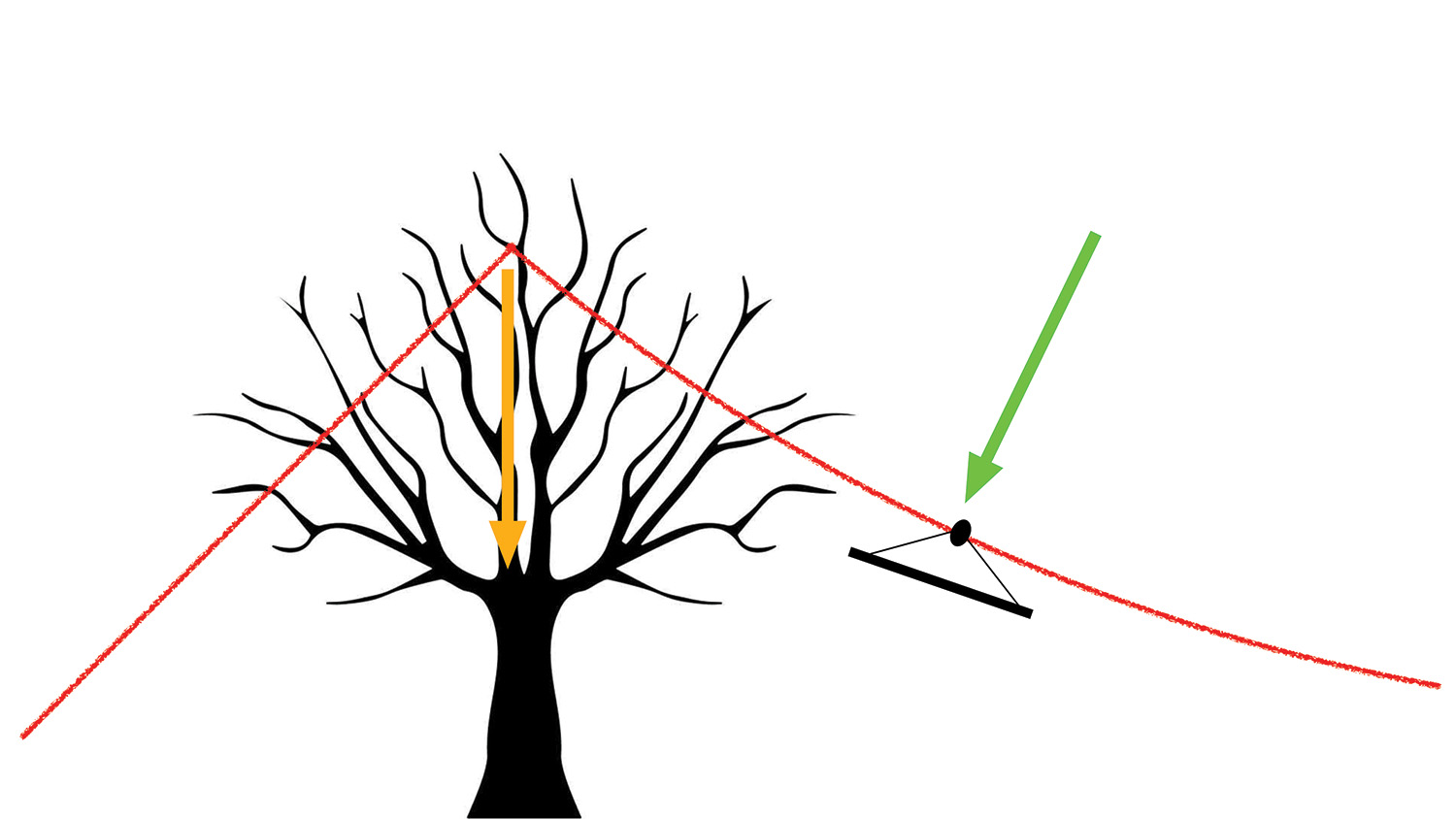
Angle at the block
Another common way to manipulate vectors in tree rigging is to change the angle at which the rope enters and/or exits the block. As this angle changes, the load the block experiences changes as well. So, too, does the resultant angle. As the angle becomes greater, the force the block experiences decreases. At 120 degrees, the force at the block becomes equal to the load. (Figure 4) For tree rigging, once the angle exceeds this magic 120-degree mark, it turns from rigging point to redirect!
This can be accomplished in many ways, with various pieces of equipment. Blocks, pulleys, rings and carabiners all can be used to deflect or change the angle at which the rope enters or exits the primary rigging point. Not only will this manipulate vectors and alter forces, it will add rope to the system and load tree parts in compression. Both are excellent ways to increase stability and strength in a rigging system.
As a general rule, I recommend using hardware that is rated for the loads you are rigging. This adds security to the system through redundancy. More so, it allows all parts of the rigging system to be used as rigging points, if necessary. With proper planning and execution, a series of rigging redirects can turn into primary rigging points as the tree is dismantled.
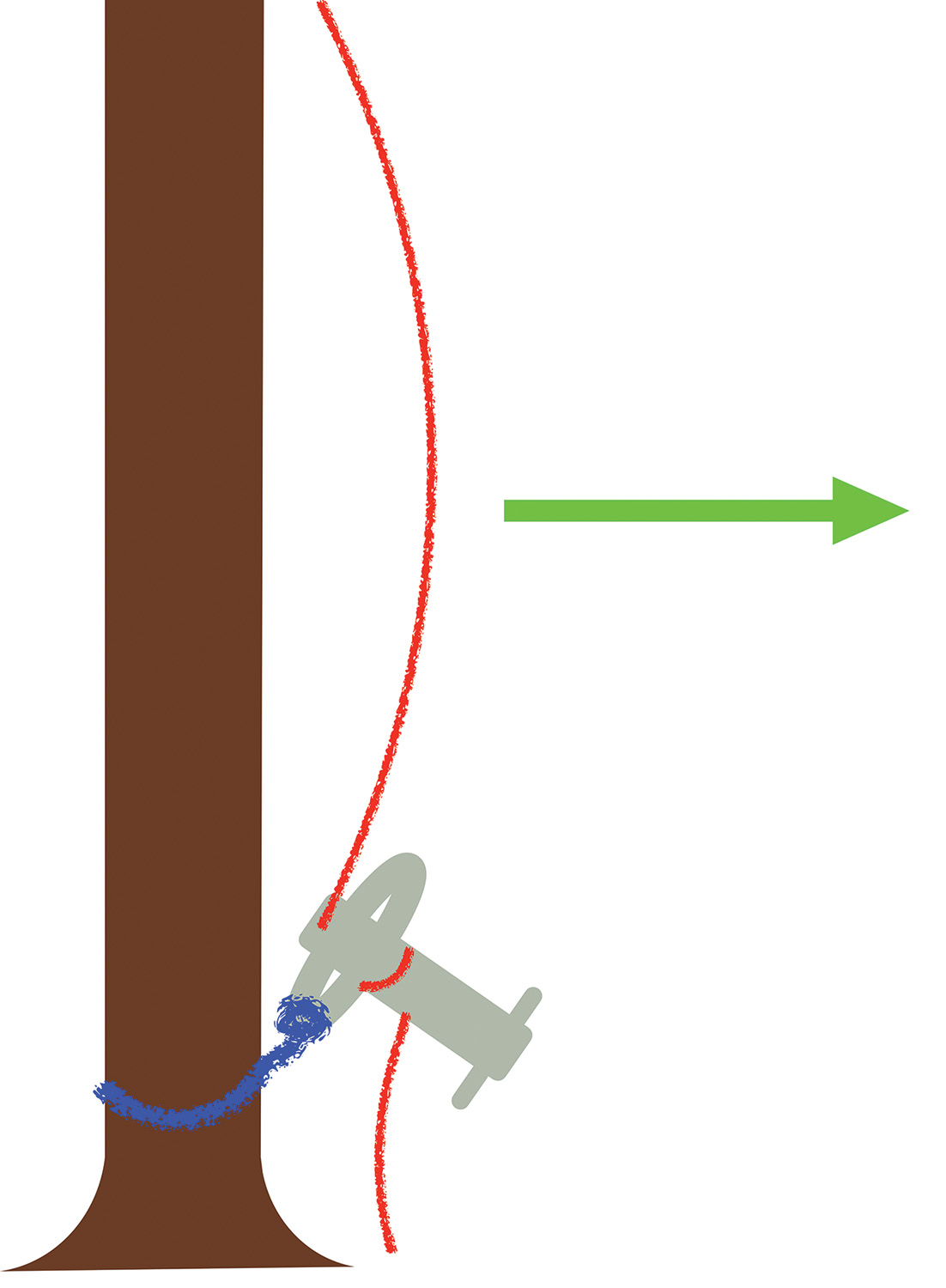
Conclusion
Accurately defining vectors and forces and determining angles and loads helps us understand principles that can be applied with many methods. But it need not be overly complex. Calculating the esoteric math and determining exact loads is possible, but not necessary. Use good judgment and experience.
Estimate loads to the best of your ability with the tools available to you. Use rated, well-cared-for hardware and textiles. Take the time to plan and inspect the tree and its structure for strengths and weaknesses. Work with the tree and build rigging systems that load the tree in compression. Build rigging systems that enhance the flow of work on the ground, not hinder it.
Focus on combining as many of the methods as possible to make your rigging systems redundant and efficient. Be willing to adapt the plan as the conditions and the tree change, and the inevitable mishap will be much less impactful and most likely just a good story once the job is done.
Anthony Tresselt, CTSP, is a consultant serving as director of safety and training for Arborist Enterprises Inc., an accredited, 31-year TCIA member company based in Manheim, Pennsylvania. He is also an independent trainer based in Manheim. He is a co-founder of The Arborist Boot Camp (thearboristbootcamp.com) and an author. His writing, thoughts and additional credentials can be found on his blog, gravitationalanarchy.com.




